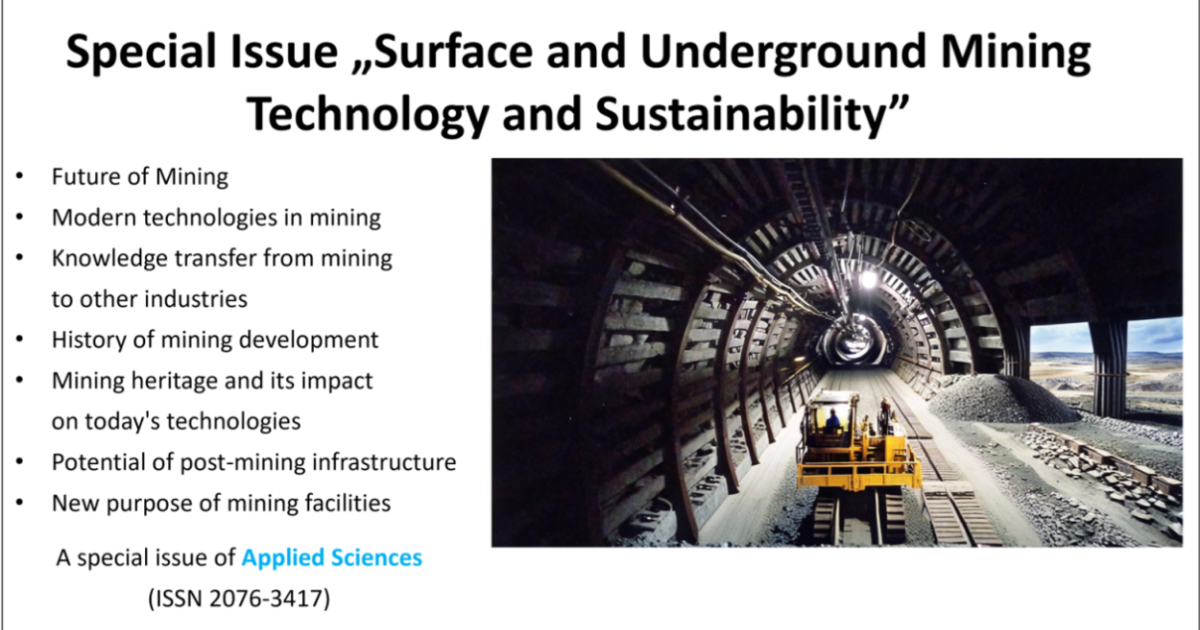- 2.5Impact Factor
- 5.5CiteScore
- 20 daysTime to First Decision
Surface and Underground Mining Technology and Sustainability
This special issue belongs to the section “Earth Sciences“.
Special Issue Information
Dear Colleagues,
Mining has accompanied man for a very long time and is one of the key industries. For many years, mining has been a driving force and has also contributed to the development of other industries and new technologies. It should be noted that working conditions in mines are very difficult and specific. Consequently, the technologies and machinery used in the mines also required careful and appropriate thought and design. Nowadays the emphasis on development has shifted to other industries; however, new trends and modern and advanced solutions using technological achievements are still being applied in the mining industry. The applicability of simulation research supports the mining industry both in the design of new machines and the development of new technologies, as well as in the process of optimizing and modernizing existing machines and introducing automation in mines. Another aspect of modern mines is the use of numerous sensors and the development of a way to transmit signals. Thus, it introduces the possibility of optimizing the operation of machinery and predictive maintenance but also minimizing the number of necessary miners in the most dangerous areas. Another aspect of the application of modern technology is the aspect of monitoring and revitalizing the sites of waste generated by the production process. In the aspect of mine closure, especially in the context of the European mine closure policy, work is also being carried out to apply modern and innovative technologies to develop post-mining infrastructure.
Dr. Kamil Szewerda
Guest Editor
Manuscript Submission Information
Manuscripts should be submitted online at www.mdpi.com by registering and logging in to this website. Once you are registered, click here to go to the submission form. Manuscripts can be submitted until the deadline. All submissions that pass pre-check are peer-reviewed. Accepted papers will be published continuously in the journal (as soon as accepted) and will be listed together on the special issue website. Research articles, review articles as well as short communications are invited. For planned papers, a title and short abstract (about 250 words) can be sent to the Editorial Office for assessment.
Submitted manuscripts should not have been published previously, nor be under consideration for publication elsewhere (except conference proceedings papers). All manuscripts are thoroughly refereed through a single-blind peer-review process. A guide for authors and other relevant information for submission of manuscripts is available on the Instructions for Authors page. Applied Sciences is an international peer-reviewed open access semimonthly journal published by MDPI.
Please visit the Instructions for Authors page before submitting a manuscript. The Article Processing Charge (APC) for publication in this open access journal is 2400 CHF (Swiss Francs). Submitted papers should be well formatted and use good English. Authors may use MDPI's English editing service prior to publication or during author revisions.
Keywords
- mining
- technology
- industry
- simulation
- machine
- FEM
- DEM
- MBS

Benefits of Publishing in a Special Issue
- Ease of navigation: Grouping papers by topic helps scholars navigate broad scope journals more efficiently.
- Greater discoverability: Special Issues support the reach and impact of scientific research. Articles in Special Issues are more discoverable and cited more frequently.
- Expansion of research network: Special Issues facilitate connections among authors, fostering scientific collaborations.
- External promotion: Articles in Special Issues are often promoted through the journal's social media, increasing their visibility.
- e-Book format: Special Issues with more than 10 articles can be published as dedicated e-books, ensuring wide and rapid dissemination.

